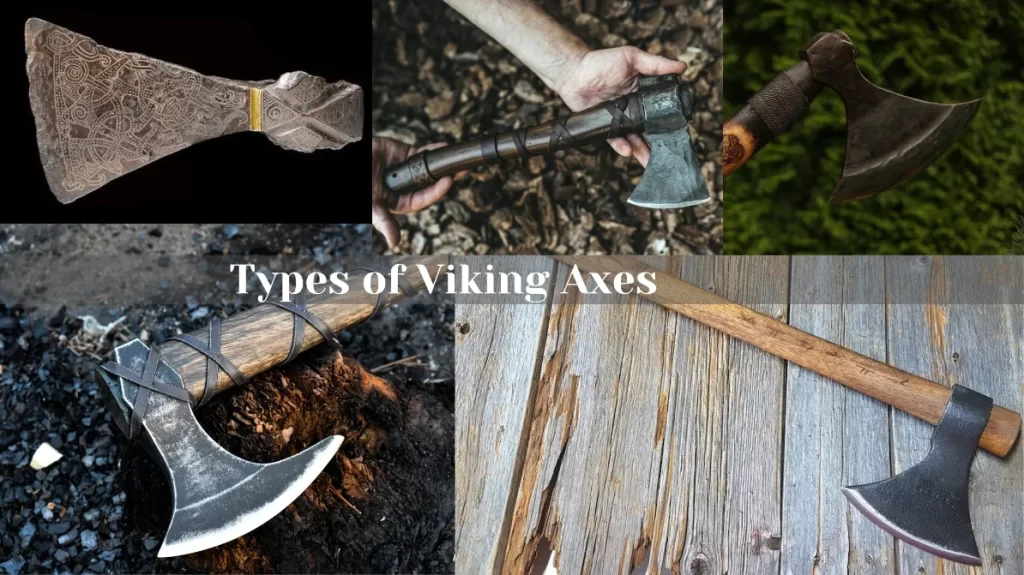Have you ever wondered what kind of axes the Vikings used to chop wood, carve ships, and fight their enemies? If you have, you might have come across the term “bearded axe” in your research. But what exactly is a bearded axe and why is it called that?

Contents
What is a Bearded Axe?
The name “bearded axe” comes from the shape of the axe head, which has a long lower edge that extends below the width of the butt. This resembles a human beard, hence the name.
Let’s explore in detail the origin, design, and uses of the bearded axe, also known as the “Skeggøx” in Old Norse.
History of the Bearded Axe
The bearded axe is thought to have originated in Scandinavia during the Viking Age. It is one of the oldest types of axes in human history. It dates back to at least the 6th century BC, when it was used by the Celts and other Iron Age peoples in Europe.
The Vikings were basically farmers and steelmakers, but they were famous for their raids, trade, and exploration across Europe and beyond. They used the bearded axe as both a tool and a weapon, for various purposes such as woodworking, shipbuilding, hunting, and combat. The bearded axe became a symbol of Viking culture and identity, and was often decorated with intricate patterns or inscriptions.
The bearded axe was also used by other peoples who came into contact with or were influenced by the Vikings, such as the Anglo-Saxons, Normans, Rus’, and Byzantines. The bearded axe remained popular until the 13th century, when it was gradually replaced by other types of axes or weapons. However, some modern woodworkers and enthusiasts still use or collect bearded axes today.
Some examples of historical figures or events that involved the bearded axe are:
- King Ragnar Lodbrok (Lothbrok) – a legendary Viking ruler who is said to have used a bearded axe named Kráka (Crow) in his raids and battles.
- The Battle of Stamford Bridge in 1066 – where a single Viking warrior armed with a bearded axe reportedly held off an entire army of Anglo-Saxons on a narrow bridge until he was killed from below.
- The Bayeux Tapestry – a famous embroidery that depicts the Norman conquest of England in 1066. The tapestry shows many scenes of Norman knights and soldiers wielding bearded axes against their Anglo-Saxon foes.
Also, read a detailed history of Viking axe.
Design of the Viking Bearded Axe
The principal aspect that defines the unique design of the bearded axe is its ‘beard’. But, why the ‘beard’? The main feature is the long lower edge or “beard” of the axe head, which provides a wide cutting surface while keeping the overall mass of the axe low.
Asides from giving the bearded axe a distinctive look, the ‘beard’ had a critical functional role. It allowed the user to grip the haft just below the axe head for controlled carving or trimming, making it an excellent tool for woodworking. The beard can also be used as a hook to pull or disarm an opponent in combat.
The longer edge length provided by the ‘beard’ also allowed for larger cutting surface, making the bearded axe efficient for chopping and combat. Despite the longer cutting edge, the axe head’s weight was significantly reduced due to the distinct design, ensuring it was easier to handle during battles and various chores.
Head
The shape and size of the bearded axe head varied depending on its intended use and preference of its maker. Some bearded axes had narrow heads with long beards, while others had broad heads with short beards.
On the other hand, some had straight edges, while others had curved or angled edges. Some had symmetrical heads, while others had asymmetrical heads with one side longer than the other. The length of the cutting edge ranged from 15 to 25 cm (6 to 10 inches).
Haft (Handle)
The handle of the bearded axe was usually made of wood, such as ash or oak. The length of the handle also varied depending on its use and preference. Some handles were short (about 30 cm or 12 inches), while others were long (up to 150 cm or 60 inches).
The longer handles gave more leverage and reach, but were heavier and harder to maneuver. The shorter handles gave more speed and agility, but were less powerful and effective.
Attachment
The bearded axe head was attached to the handle by a wooden wedge or a metal rivet. The head was either socketed or eye-shaped, meaning that it had a hole or a slot for the handle to fit into.
The socketed heads were more secure and durable, but required more skill and materials to make. The eye-shaped heads were easier and cheaper to make, but were more prone to loosening or breaking.
Comparison with Other Types of Axes
The bearded axe differs from other types of axes in several ways. Compared to a normal axe, the bearded axe has a longer cutting edge and a lighter head, which makes it more versatile and efficient.
Compared to a tomahawk, the bearded axe has a larger and heavier head, which makes it more powerful and durable.
And, compared to a Dane axe, the bearded axe has a shorter and narrower head, which makes it more precise and agile.
Read the difference between Viking axes and a Medieval axes.
Uses of the Bearded Axe
The bearded axe is a versatile and effective tool that can be used for various purposes and situations. Here are some of the advantages of using a bearded axe:
Woodworking
The bearded axe can be used to chop, split, carve, shave, or plane wood with ease and accuracy. The long cutting edge allows for smooth and even cuts, while the beard allows for fine adjustments and corrections. The user can also grip the handle behind the head for more control and precision.
A bearded axe can be used to make furniture, boats, houses, shelters, or sculptures out of wood. These axes are still being used by woodworkers for tasks such as hewing logs, planing wood, and carving intricate designs.
Hunting
The bearded axe can be used to kill, skin, or butcher animals with speed and efficiency. The sharp edge can pierce through flesh and bone, while the beard can hook or pull the animal’s limbs or hide.
The user can also throw the bearded axe at a target from a distance with accuracy and force to hunt deer, boar, bear, or other game animals.
Combat
In the realm of combat, the bearded axe served as an effective tool due to its reach and weight distribution. Fighters could grip it higher up the haft for closer, more controlled strikes, or lower down for sweeping attacks. It can be used to strike, slash, or hook an enemy with power and skill.
The long edge can inflict deep wounds or sever limbs, while the beard can disarm or drag an enemy’s weapon or shield. Indeed, the bearded axe stood as a symbol of power and resilience in the Viking era. A bearded axe can be used to fight against swordsmen, spearmen, archers, or other axemen.
Everyday Life
Bearded axes are popular among bushcrafters, who use them for tasks such as chopping wood, building shelters, building fences, and preparing food.
What Is the Significance of Bearded Axe in Viking Culture?
Even though the bearded axe was originated before the Viking age, but it got popular during this age when Vikings started using it for almost every task. The bearded axe was a versatile weapon that could be used for both combat and everyday tasks.
In combat, it was an effective weapon against both armored and unarmored opponents. The long, narrow blade could pierce through armor, while the axe beard could be used to hook and disarm opponents. Outside of combat, the Vikings used the bearded axe for chopping wood, building houses and ships, and hunting, etc.
The bearded axe was also a significant cultural symbol for the Vikings. It was associated with strength, courage, and masculinity. Vikings often carried their bearded axes with them as a way to show their status and their commitment to their culture.
Final Words
Now we have learned what is a bearded axe, how this unique axe was created, how it varies in shape and size, and how it compares to other types of axes. It is a fascinating tool and weapon that was used by the Vikings and other ancient peoples.
The bearded axe, particularly the Viking “Skeggøx” axe, was much more than a weapon; it was a multifunctional tool that played an essential role in the daily lives of various cultures throughout history. It could chop wood, craft items, and serve as a formidable weapon in battle.
FAQs:
What is a bearded axe used for?
Bearded axes were used for a variety of purposes, including warfare, woodworking, and hunting. In battle, they were used to hook an opponent’s weapon or shield, disarming them and leaving them vulnerable to attack. Bearded axes could also be used to deliver powerful blows to the head and body of the enemy.
In woodworking, bearded axes were used for tasks such as hewing logs, planing wood, building ships and houses, and carving intricate designs. Bearded axes were also used in hunting to butcher animals, split wood for fires, and build shelters.
What is the difference between an axe and a bearded axe?
The main difference between an axe and a bearded axe is the presence of a beard, which is a portion of the blade that extends below the butt of the axe. This gives the bearded axe a number of advantages, including a wider cutting surface, a lower overall mass, and the ability to grip the haft directly behind the head.
What is the bearded axe made of?
Bearded axes are typically made with a forged steel head and a wooden haft. The head of the axe is usually attached to the haft by a wedge or rivet.
Is a bearded axe a battle axe?
Yes, a bearded axe is a type of battle axe. It was a popular weapon among the Vikings and other cultures throughout history. Bearded axes were effective in both hand-to-hand combat and siege warfare.
How much does a bearded axe weigh?
The weight of a bearded axe can vary depending on its size and purpose. However, most bearded axes weigh between 1 and 2 kilograms (2.2 and 4.4 pounds).
How do I use a bearded axe safely?
When using a bearded axe, one should follow the following safety precautions:
- Always wear safety glasses and gloves to protect yourself from flying debris.
- Be aware of your surroundings and make sure that there are no people or objects in the way of your swing.
- Use a sharp axe and keep it in good condition. A dull axe is more likely to slip and cause an accident.
- Be careful not to overexert yourself when swinging the axe. Take breaks often to avoid fatigue.



